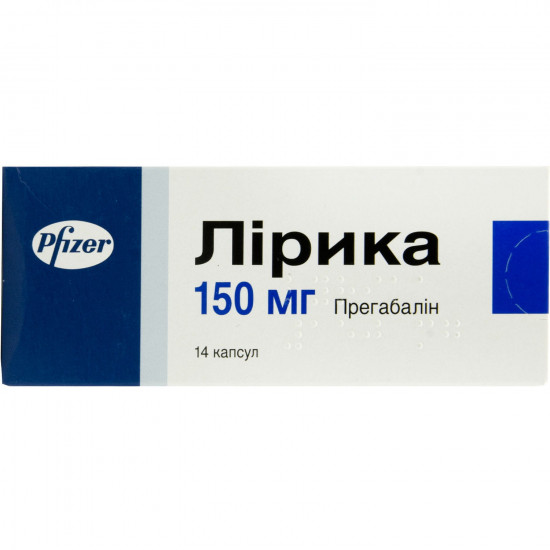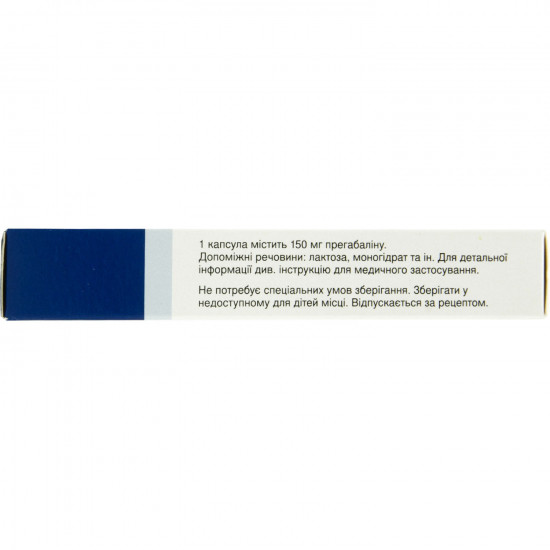



- Stock: In Stock
- Model: 184072
0% Customers recommend this product
-
5 Awesome0%
-
4 Great0%
-
3 Average0%
-
2 Bad0%
-
1 Poor0%
Reviews Over Lyrics kaps. 150 mg No. 14
- (0)
Total Reviews (0)
click here write review to add review for this product.
Report this review.
Description
LYRIC POET (LYRICA®)
PREGABALINUM N03A X16
Pfizer Inc.
STRUCTURE AND PACKAGING:
kaps. 75 mg, No. 14
kaps. 75 mg, No. 56
| Pregabalin | 75 mg |
Other ingredients: lactoses monohydrate, starch corn, talc.
No. UA/3753/01/04 from 25.05.2010 to 25.05.2015
kaps. 150 mg, No. 14
kaps. 150 mg, No. 56
| Pregabalin | 150 mg |
Other ingredients: lactoses monohydrate, starch corn, talc.
No. UA/3753/01/02 from 25.05.2010 to 25.05.2015
PHARMACOLOGICAL PROPERTIES:
Pharmacodynamics. Active ingredient — pregabalin, represents GAMK analog ((S)-3 (aminomethyl)-5-methylhexane acid).
action Mechanism . Pregabalin contacts an auxiliary subunit (α 2 -δ-белок) potentsialzavisimy calcium channels in central nervous system, actively substituting [ 3 H] - gabapentin.
Clinical experience
Neuropatichesky pain . The efficiency of medicament is shown in researches in diabetic neuropathy and post-herpetic neuralgia. The efficiency at other types of neuropatichesky pain was not studied.
Pregabalin studied in 9 controlled clinical trials lasting up to 13 weeks when dosing 2 times a day and in researches lasting up to 8 weeks with dosing 3 times a day. In general profiles of safety and efficiency for the dosing modes 2 and 3 times a day were similar.
In clinical trials lasting up to 13 weeks reduction of pain was observed on the 1st week and remained throughout the treatment period.
In controlled clinical trials at 35% of patients of group of a pregabalin and 18% of patients of group of placebo was observed improvement for 50% on a pain scale. Among persons who had no drowsiness such improvement was noted at 33% of patients of group of a pregabalin and 18% — groups of placebo. Among patients who had a drowsiness the rates of efficiency were 48% in group of a pregabalin and 16% — in group of placebo.
Fibromyalgia . Monotherapy pregabaliny was studied in 5 placebos - controlled researches: three researches of use in the fixed dose lasting 12 weeks, one — the fixed dose lasting 7 weeks and a 6-month research of long efficiency. In all researches of the fixed dose pregabalin (300–600 mg 2 times a day) provided considerable reduction of severity of the pain connected with fibromyalgia.
In three 12 weeks researches of the fixed dose at 40% of patients of group of a pregabalin was observed by 30% improvement of an indicator on a pain scale in comparison with 28% of group of placebo; at 23% of patients of group of a pregabalin the state on a scale improved for 50% in comparison with 15% of group of placebo. Pregabalin provided to
considerably the best indicators on a scale of the general assessment of general impression of the patient about changes (PGIC) in three 12 weeks researches of use of the fixed dose in comparison with placebo (41% of patients of group of a pregabalin felt much better or noted considerable improvement of a state in comparison with 29% in group of placebo). According to the questionnaire on influence of fibromyalgia (FIQ), pregabalin provided significant improvement of functions in comparison with placebo in two of three researches using the fixed dose at whom this indicator was estimated.
According to messages of patients, pregabalin provided considerable improvement of a dream in 4 researches using the fixed dose which was determined by MOS-SS sleep disorder subscale indicators (Medical scale of a research of a dream), the general index of problems of a dream MOS-SS and by diaries of sleep quality.
In a 6-month research of reduction of severity of pain the improved general assessment (PGIC), functioning (general point of FIQ) and a dream (a subscale MOS-SS sleep disorder) at patients of group of a pregabalin remained much longer, than patients have groups of placebo.
At use of 600 mg of a pregabalin a day the patients noted additional improvement of a dream in comparison with accepting 300 and 450 mg/days; average influence on pain, the general assessment and FIQ were similar to that at use of 450 and 600 mg of a pregabalin a day though the dose of 600 mg/days was slightly worse transferred.
Epilepsy . Pregabalin studied in 3 controlled clinical trials lasting 12 weeks when dosing 2 or 3 times a day. The profile of safety and efficiency for the dosing modes 2 or 3 times a day was similar.
noted Decrease in frequency of attacks on the 1st week of treatment.
Generalized Anxiety Disorder (GAD) Pregabalin studied
in 6 controlled researches lasting 4-6 weeks, at patients of advanced age for 8 weeks and in a long research of prevention of a recurrence with a 6-month double blind phase of prevention of a recurrence.
noted Reduction of expressiveness of symptoms of GTR on a scale of uneasiness of Hamilton (HAM-A) on the 1st week. In controlled clinical trials lasting 4-8 weeks at 52% of patients of group of a pregabalin and 38% of group of placebo revealed not less than 50% improvement of the general indicator of HAM-A from the initial stage to a final point.
Pharmacokinetics. Pharmacokinetic indicators of a pregabalin were similar at the healthy volunteers, patients with epilepsy using antiepileptic drugs, and patients with chronic pain.
Absorption. Pregabalin is quickly soaked up at oral administration on an empty stomach and reaches the C max in blood plasma for 1 h after single and repeated use. The calculated bioavailability of a pregabalin at oral administration is ≥90% and does not depend on a dose. After repeated use the equilibrium state is reached in 24–48 h. Extent of absorption of a pregabalin decreases at a concomitant use with food therefore the C max decreases approximately by 25–30% and the T max decreases approximately on 2.5 h. However use of a pregabalin at meal time had no clinically significant impact on the volume of its absorption.
Distribution . In preclinical trials it was established what pregabalin easily gets through GEB at animals and also through a placenta at rats and it is allocated with milk during feeding by a breast. At the person the conditional volume of distribution of a pregabalin after oral administration is about 0.56 l/kg. Pregabalin does not contact proteins of blood plasma.
Metabolism . At the person pregabalin it is slightly metabolized. After introduction of a dose about 98% it are radioactive a marked pregabalin it is removed with urine in the form of not changed drug. N-metilirovanny a derivative of a pregabalin (main metabolite of a pregabalin which is defined in urine) made 0.9% of the entered dose. In preclinical trials the lack of racemization of S-enantiomera in R-enantiomer was shown.
Removal . Pregabalin is brought from a system blood-groove generally due to excretion by kidneys in the form of not changed drug. Average T ½ pregabalina makes 6.3 h. Plasma and renal clearance of a pregabalin are directly proportional to clearance of creatinine. Patients with a renal failure or being on a hemodialysis need to adjust a medicament dose.
Linearity/nonlinearity . The pharmacokinetics of a pregabalin is linear for all recommended interval of doses. Intersubject pharmacokinetic variability for a pregabalin low (<20%). The pharmacokinetics of repeated doses is predicted on the basis of data of single dosing. Thus, there is no need for regular monitoring of concentration of a pregabalin for blood plasma.
Pharmacokinetics at separate groups of patients
Floor. Results of clinical trials demonstrate lack of clinically significant influence of a floor on concentration of a pregabalin in blood plasma.
Renal failure. Clearance of a pregabalin is directly proportional to clearance of creatinine. Besides, pregabalin it is effectively brought out of blood plasma at a hemodialysis (after 4 h a hemodialysis the concentration of a pregabalin in blood plasma decreases approximately by 50%). As generally medicament is removed by kidneys, at patients with a renal failure it is necessary to reduce its dose, and after a hemodialysis — to accept an additional dose.
Abnormal liver function. Special pharmacokinetic researches with participation of patients with an abnormal liver function were not conducted. As pregabalin is not exposed to significant metabolism and it is removed mainly in the form of not changed medicament with urine, it is improbable that the abnormal liver function could affect concentration of a pregabalin in blood plasma.
Patients of advanced age (65 years are more senior). Clearance of a pregabalin tends to decrease with age that will be coordinated with decrease in clearance of the creatinine which is also connected with increase in age. At patients with considerable depression of function of kidneys the dose decline of a pregabalin can be necessary.
Preclinical data on safety pregabalin was well transferred by
In the standard researches of pharmacological safety to animals at introduction in clinically significant doses. In toxicity researches on rats and monkeys noted influence on central nervous system, including hypoactivity, hyperactivity and an ataxy. Growth of frequency of development of an atrophy of a retina was revealed, as a rule, at old rats of albinos after long introduction of a pregabalin in doses of ≥5 times exceeding an average value of exposure at the person at use in most recommended clinical doses.
Teratogenecity. Pregabalin did not reveal teratogenecity at mice, rats and rabbits. The fetal toxicity at rats and rabbits was noted only on exposures, much higher, than at the person. In a research of prenatal/post-natal toxicity pregabalin served as the reason of toxic influence on development of posterity of rats at use in the doses more than twice exceeding most recommended exposure at the person.
Mutagenicity. by results of analyses in vitro and the in vivo pregabalin is not genotoksichesky.
Carcinogenicity. Two years' studying carcinogenicity of a pregabalin was carried out on rats and mice. Development of tumors is noted at rats at administration of medicament in the doses, by 24 times exceeding average exposure at the person at use in most recommended clinical dose — 600 mg/days. At mice the increase in frequency of development of tumors on the exposures similar to average exposure at the person is not revealed, but at reception in higher doses noted growth of frequency of development of a hemangiosarcoma. The Negenotoksichesky mechanism of development of the pregabalin-induced tumor in mice included changes of thrombocytes and the corresponding proliferation of cells of an endothelium. According to results of short-term researches and limited these long-term researches of such changes of thrombocytes did not reveal neither at rats, nor at the person. There are no proofs of presumable communication with it of risk for the person.
At young rats toxicity types qualitatively did not differ from revealed at mature animals; though young rats are more sensitive. On therapeutic exposures noted clinical signs of hyperactivity and a bruxism from central nervous system and some changes of development (temporary slowing down of increase in body weight). Influence on the period of an estrus was revealed at use of the doses, by 5 times exceeding therapeutic exposure at the person. Neuropovedencheskiye/kongitivny effects noted at young rats in 1–2 weeks after exposure, twice (reaction to an acoustic irritant) or by 5 times (ability to training/memory) exceeded therapeutic exposure at the person. Decrease in the answer to an acoustic irritant was noted at young rats in 1–2 weeks after introduction in the doses twice exceeding therapeutic for the person. In 9 weeks it is the phenomenon it was not noted.
INDICATION:
neuropatichesky pain at adults;
epilepsy (as means of additional therapy of partial (partial) attacks at adults with/without secondary generalization);
GTR at adults;
fibromyalgia.
USE:
medicament is appointed in the dose 150–600 mg/days divided into 2 or 3 receptions. Medicine of the Lyric poet can be applied irrespective of meal.
Neuropatichesky pain . The initial dose of a pregabalin makes 150 mg/days. Depending on individual reaction of the patient and tolerance of medicament the dose can be raised in 3–7 days to 300 mg/days and if it is necessary, it can be also raised to maximum (600 mg/days) in 7 days.
Fibromyalgia . Usually the medicament dose for most of patients makes 300–450 mg/days divided into 2 receptions. The dose of 600 mg/days can be necessary for some patients. Administration of medicament it is necessary to begin with a dose 75 mg 2 times a day (150 mg/days) and to raise, depending on efficiency and shipping, to 150 mg 2 times a day (300 mg/days) for 1 week. Patients at whom dosing of 300 mg/days is insufficiently effective can raise a dose to 225 mg 2 times a day (450 mg/days). If it is necessary, the dose can be raised in a week to maximum — 600 mg/days
Epilepsy . The initial dose of a pregabalin makes 150 mg/days. Depending on individual reaction of the patient and tolerance of medicament the dose can be raised to 300 mg/days in 1 week. In 1 week the dose can be raised to maximum — 600 mg/days
GTR . The daily dose varies from 150 to 600 mg, divided into 2 or 3 receptions. Need of treatment pregabaliny has to be reconsidered regularly.
Treatment pregabaliny can be begun with a dose of 150 mg/days. Depending on individual reaction and tolerance of medicament the dose can be raised to 300 mg/days after the 1st week of treatment. On an extent on following weeks treatments the dose can be raised to 450 mg/days. In 1 week the dose can be raised to maximum — 600 mg/days
Cancellation of Lyrics . If pregabalin it is necessary to cancel, it is recommended to stop gradually administration of medicament for not less than 1 week
Patients with a renal failure . The medicament dose decline at patients with impaired renal function should be carried out individually, taking into account clearance of creatinine as it is specified in the table which is determined by a formula: clearance of creatinine, ml/min. = ([140 – age (years)] × the body weight (kg)/72 × the level of creatinine in serum (mg/dl)) × (0.85 — for women) .
At patients to whom the hemodialysis was carried out a daily dose of a pregabalin has to be raised taking into account function of kidneys. In addition to a daily dose right after the 4-hour procedure of a hemodialysis the medicament dose which is determined by the table has to be accepted.
Dose adjustment of a pregabalin taking into account a functional condition of kidneys
| Clearance of creatinine, ml/min. | Total daily dose of a pregabalin * | dosing Mode | |
|---|---|---|---|
| Initial dose, mg/days | Maximum dose, mg/days | ||
| ≥60 | 150 | 600 | time2 or 3 in day |
| ≥30-<60 | 75 | 300 | time2 or 3 in day |
| ≥15-<30 | 25-50 | 150 | time1 or 2 in day |
| <15 | 25 | 75 | 1 times a day |
| Additional daily dose after a hemodialysis, mg | |||
| 25 | 100 | Single dose + | |
* the Total daily dose (mg/days) it is necessary to divide into the number of receptions to receive the number of mg on a dose.
+ Additional dose — a single additional dose.
Patients with an abnormal liver function . With abnormal liver functions of dose adjustment it is not required from patients.
Use for patients of advanced age (65 years are more senior) . At patients of advanced age the dose decline of a pregabalin in connection with depression of function of kidneys can be necessary.
CONTRAINDICATION:
hypersensitivity to active ingredient or any of auxiliary components.
SIDE EFFECTS:
more than 12,000 patients, from them 7000 — participants of double blind placebos - controlled researches took part in the clinical program concerning use of a pregabalin.
Most often noted such side effects as dizziness and drowsiness. Side effects at medicament use most often were slightly or are moderate. In all controlled researches the medicament withdrawal rate in connection with development of side reactions was 14% among patients who applied pregabalin, and 7% among the patients receiving placebo. Dizziness and drowsiness were the most widespread side reactions which emergence led to an exception of group of use of a pregabalin.
Separate side reactions connected with use of a pregabalin, according to the analysis of cumulative these clinical trials, are listed on classes of systems of bodies and frequency: very often (> 1/100), it is frequent (> 1/100, <1/10), infrequently (> 1/1000, <1/100) and is rare (<1/1000).
Emergence of the listed side effects could be connected with a course of a basic disease or the accompanying use of other medicines.
Infection and invasion: infrequently — a nasopharyngitis.
from the system of blood and lymphatic system: it is rare — a neutropenia.
from metabolism and food: it is frequent — increase in appetite; infrequently — anorexia; seldom — a hypoglycemia.
Mental disturbances: it is frequent — confusion of consciousness, a disorientation, irritability, euphoria, decrease in a libido, insomnia; infrequently — depersonalization, an anorgazmiya, concern, a depression, excitement, changes of mood, difficulty with selection of words, hallucinations, unusual dreams, increase in a libido, the panic attacks, apathy; seldom — sexual freedom, high spirits.
With sides of nervous system: it is very frequent — dizziness, drowsiness; often — an ataxy, a lack of coordination, balances, amnesia, attention disorders, a memory impairment, a tremor, a dysarthtia, paresthesias, a sedation, a lethargy; infrequently — disturbance of mnestic function, a hypesthesia, a nystagmus, disturbance of the speech, a myoclonus, hyporeflexia, dyskinesia, psychomotor hyperactivity, postural dizziness, a hyperesthesia, an ageusia (loss of flavoring sensitivity), burning sensation, an intentsionny tremor, a stupor, a syncope; seldom — a hypokinesia, a parosmiya, a dysgraphia.
With sides of an organ of sight: it is frequent — illegibility of sight, a diplopia; infrequently — disorders of vision, defect of a field of vision, xerophthalmus, swelling of eyes, decrease in visual acuity, eye pain, an asthenopia, the raised dacryagogue; seldom — a photopsia, irritation of eyes, a mydriasis, an ostsilopsiya, change of visual depth of perception, loss of peripheral sight, a strabismus (squint).
With sides of an organ of hearing and vestibular disorders: it is frequent — vertigo (dizziness); seldom — a hyperacusia.
With parties of a cardiovascular system: infrequently — AV blockade of the I degree, tachycardia, hyperaemia, arterial hypotension, AG, rushes of blood, pokholodeny extremities; seldom — sinus tachycardia, a sinus arrhythmia, sinus bradycardia.
With parties of a respiratory system: infrequently — short wind, cough, dryness in a nose; seldom — congestion of a nose, nasal bleeding, rhinitis, snore, feeling of squeezing in a throat.
With sides of a GIT: it is frequent — vomiting, an abdominal distension, a constipation, vomiting, dryness in a mouth, a meteorism; infrequently — hypersalivation, a gastroesophageal reflux, an oral hypesthesia; seldom — ascites, a dysphagy, pancreatitis.
With sides of skin: infrequently — sweating, papular rash; seldom — cold sweat, a small tortoiseshell.
With sides of the musculoskeletal system and connective tissue: infrequently — a fastsikulyation (twitching) of muscles, hypostasis of joints, myotonia, myalgia, an arthralgia, a dorsodynia, extremity pain, muscle tension; seldom — a spasm of muscles of a neck, neck pain, a rhabdomyolysis.
With sides of kidneys and urinary tract: infrequently — a dysuria, urine incontinence; seldom — an oliguria, a renal failure.
Disorder of reproductive function and disturbances with sides of mammary glands: it is frequent — erectile dysfunction; infrequently — an ejaculation delay, sexual dysfunction; seldom — an amenorrhea, morbidity of mammary glands, discharges from mammary glands, a dysmenorrhea, a hypertrophy of mammary glands.
General disorders and changes in the injection site: it is frequent — peripheral hypostases, disturbance of gait, feeling of intoxication, increased fatigue; infrequently — feeling of squeezing in a thorax, generalized hypostases, pain, a fever, an asthenia, thirst; seldom — a pyrexia.
Influence on results of laboratory researches: it is frequent — increase in body weight; infrequently — increase in the AlAT, AsAT and KFK level in blood plasma, reduction of quantity of thrombocytes; seldom — increase in level of glucose in blood, concentration of creatinine in blood, decrease in potassium concentration in blood, reduction of quantity of leukocytes in blood, degrowth of a body.
was reported About the following side reactions throughout the period of post-marketing observation:
from the immune system: Quincke's disease, allergic reactions, hypersensitivity;
from nervous system: headache, loss of consciousness, deterioration in mental activity;
from mentality: aggression;
from heart: stagnant heart failure, prolongation of an interval Q-T ;
from an organ of sight : keratitis, loss of sight;
from a GIT : paraglossa, diarrhea, nausea;
general state and changes in the injection site: indisposition;
from skin and hypodermic cellulose : a face edema, an itching, Stephens's syndrome — Johnson;
from kidneys and an urinary system : ischuria;
from respiratory organs and a thorax: fluid lungs.
SPECIAL INSTRUCTIONS:
patients with rare hereditary diseases: intolerance of a galactose, deficiency of Lappa lactase or glyukozo-galaktozny malabsorption should not use this drug.
Some patients with diabetes at which during treatment pregabaliny body weight increased need carrying out dose adjustment of gipoglikemiziruyushchy drugs.
during post-marketing observations appeared messages about emergence of reactions of hypersensitivity, including cases of development of a Quincke's disease. It is necessary to stop immediately use of a pregabalin at emergence of such symptoms of a Quincke's disease as edema of face, circumoral area or upper airways.
Use of a pregabalin was followed by cases of dizziness and drowsiness that can increase the frequency of developing of accidental injuries (falling) at people of advanced age. Post-marketing messages about a loss of consciousness, confusion of consciousness, deterioration in mental activity are received. Therefore it is necessary to recommend to patients to be careful until potential individual impacts of medicament are known to them.
In post-market researches was reported about temporary illegibility of sight and other changes of sight at the patients applying pregabalin. After medicament withdrawal such symptoms can disappear or decrease their expressiveness.
is Not enough data on cancellation of the accompanying antiepileptic medicaments after achievement of control over spasms at addition of a pregabalin to the carried-out therapy, upon transition to monotherapy pregabaliny.
After the termination of short-term and prolonged use of a pregabalin at some patients noted cancellation symptoms. It was reported about such phenomena: insomnia, headache, nausea, uneasiness, hyperhidrosis and diarrhea.
Though influence of medicament withdrawal on return of symptoms of a renal failure systematically was not studied, reported about improvement of function of kidneys after medicament withdrawal or a dose decline of a pregabalin.
Though the causal relationship between use of a pregabalin and stagnant heart failure was not established, during the post-marketing period it was reported about cases of stagnant heart failure at the patients applying pregabalin. In short-term researches with participation of patients without clinically significant heart diseases or peripheral vessels the significant communication between peripheral hypostasis and complications from a cardiovascular system was not noted, such as AG or stagnant heart failure. As there are not enough data on use of medicament for patients with heavy stagnant heart failure, pregabalin at them it is necessary to apply with care.
Use during pregnancy and feeding by a breast.
Pregnancy. Data relatively uses of a pregabalin during pregnancy are absent. Researches on animals demonstrate reproductive toxicity. The potential risk for the person is unknown. Therefore pregabalin it is not necessary to apply during pregnancy, except for separate cases when the advantage for mother obviously exceeds possible risk for a fruit. Women of childbearing age need to apply effective remedies of contraception.
Feeding by a breast. Does not know whether it is excreted pregabalin in breast milk; however it is defined in milk of rats. Therefore feeding by a breast during treatment pregabaliny is not recommended.
Children. Safety and efficiency of a pregabalin at children aged up to 12 years and teenagers was not studied. It is not recommended to use medicament at children.
Influence on speed of response at control of vehicles or work with other mechanisms. Drug Lyrics can cause dizziness and drowsiness and also to affect ability to run vehicles or to work with mechanisms. Therefore patients should refrain from driving or work with a difficult technique until it becomes known, how exactly medicament affects ability to such activity.
INTERACTION:
as the medicament Lyrics is mainly excreted by in not changed view with urine and only slightly metabolized in a human body (<2% of the entered dose are removed with urine in the form of metabolites), does not inhibit the in vitro metabolism of other medicaments and does not contact blood proteins, it is improbable that pregabalin can enter pharmacokinetic interaction with other medicines or to be object of similar interaction.
According to it, in the researches in vivo did not note significant clinical pharmacokinetic interaction between pregabaliny and Phenytoinum, carbamazepine, valproic acid, lamotridzhiny, gabapentiny, lorazepam, oxycodone or ethanol. Besides, the carried-out pharmacokinetic population analysis showed that oral anti-diabetic drugs, diuretics, insulin, phenobarbital, tiagabin and topiramat did not reveal clinically significant influence on clearance of a pregabalin.
Simultaneous use of a pregabalin and oral contraceptives — Norethisteronum and/or ethinylestradiol — does not influence pharmacokinetics in an equilibrium condition of each of drugs.
Pregabalin can exponentiate effect of ethanol and lorazepam. In controlled clinical trials the multiple oral administration of doses of a pregabalin and oxycodone, lorazepam or ethanol had no clinically significant impact on breath function. During post-marketing observation it was reported about development of respiratory insufficiency and a coma in patients which at the same time accepted pregabalin and other depressants of central nervous system. Pregabalin strengthened disturbance mnestic and the main motive functions caused by oxycodone. Post-marketing messages about the phenomena connected with decrease in functions of lower parts of a GIT (for example intestinal impassability, paralytic intestinal impassability, a constipation) in case of the accompanying use of a pregabalin with medicaments which can be the cause of a constipation, such as opioid anesthetics are received.
did not conduct Special researches of pharmakodinamichesky interactions at volunteers of advanced age.
OVERDOSE:
at administration of medicament in a dose up to 15 g of any additional side effects was not noted.
In post-marketing observations most often noted such side reactions at use of a pregabalin in an overdose: affective disorders, drowsiness, confusion of consciousness, depression, agitation, concern.
Treatment of overdose has to include the standard supporting actions and, if necessary, carrying out a hemodialysis.
STORAGE CONDITIONS:
in inaccessible for children, the dry place at a temperature below 25 °C.
Description of goods is certified by Pfizer producer .
Editorial group Date of creation: 04.01.2023 Date of updating: 05.04.2023Pay attention!
Description of the medicament Lyrics kaps. 150 mg No. 14 on this page — the simplified author's version of website apteka911 created on the basis of the instruction(s) for use. Before acquisition or use of medicament you have to consult with the doctor and study the original instruction of the producer (it is applied to each packing of drug).
Information on medicament is provided toonly with the fact-finding purpose and should not be used as the management to self-treatment. Only the doctor can make the decision on prescribing of medicament and also define doses and ways of its use.
Specifications
| Characteristics | |
| Active ingredients | Pregabalin |
| Amount of active ingredient | 150 mg |
| Applicant | Pfizer |
| Code of automatic telephone exchange | N03AX16 Pregabalin |
| Interaction with food | It doesn't matter |
| Light sensitivity | Not sensitive |
| Market status | Original |
| Origin | Chemical |
| Prescription status | According to the prescription |
| Primary packing | blister |
| Producer | PFIZER OF MENYUFEKCHURING DOYCHLAND GMBH |
| Quantity in packing | 14 capsules |
| Release form | capsules for internal use |
| Route of administration | Oral |
| Sign | Import |
| Storage temperature | from 5 °C to 25 °C |
| Trade name | Lyrics |
















































